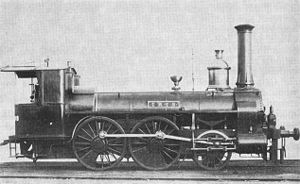KFNB - Nestor to Ariadne, Bihar to Üllö, Jason II
| KFNB "NESTOR" to "ARIADNE", "BIHAR" to "Üllö", "JASON II" | |
|---|---|
|
KFNB "Iris"
|
|
| Type : | 1B n2 |
| Fixed wheelbase: | 3,319 mm |
| Total wheelbase: | 3,319 mm |
| Empty mass: | 27.0 t |
| Service mass: | 29.0 t |
| Friction mass: | 19.0 t |
| Driving wheel diameter: | 1,581 mm |
| Impeller diameter front: | 1,120 mm |
| Cylinder diameter: | 395 mm |
| Piston stroke: | 580 mm |
| Boiler overpressure: | 5.4 bar |
| Radiant heating surface: | 6.70 m² |
| Tubular heating surface: | 74.90 m² |
The steam locomotives "NESTOR" to "ARIADNE" , "BIHAR" to "Üllö" and "JASON II" were passenger locomotives of the KFNB .
All locomotives (except BIHAR to ÜLLÖ) were delivered from the locomotive factory of the Wien-Gloggnitzer Eisenbahngesellschaft in Vienna to the KFNB with the axle formula 1B from 1846 to 1851 , they came from the first attempt by John Haswell , the factory manager, to develop a standard type. Many of the components of this machine were identical to those of the freight locomotives "AUSTRIA II" to "SALAMANDER" .
The locomotives were a further development of Stephenson's long boiler design. They had inner frames and horizontal cylinders on the outside. The wheels were provided with counterweights and there was already a sand spreader in front of the drive wheels.
Between 1853 and 1865 all machines got bigger boilers. From 1866 onwards, all locomotives were reconstructed, ie they got new boilers and other modifications were carried out so that they differed from one another in details. The table shows the original dimensions.
In 1856 the KFNB bought the locomotives BIHAR to ÜLLÖ from the Hungarian Central Railway (see UZB - Czegled to Bihar )
The machines of this type later formed the KFNB series IIIa .
The "NAGYMAROS" was converted into a compound machine 1B-n2v in 1879. But since they were not satisfied with it, it was rebuilt into a twin type in 1881.
The "MINERVA" was converted into a small-wheeled freight locomotive and came to the BBÖ as 289.13 , where it was retired in 1924. All other machines were retired between 1881 and 1900.
literature
- Alfred Horn: The Kaiser-Ferdinands-Nordbahn , The Austrian-Hungarian Railways, Volume 2, Bohmann Verlag, 1970
- Karl Gölsdorf : Locomotive construction in old Austria 1837-1918 , Slezak publishing house , 1978, ISBN 3-900134-40-5

